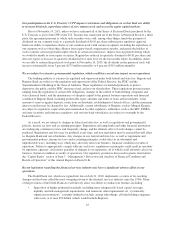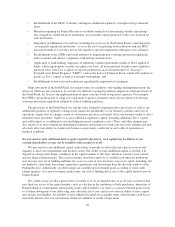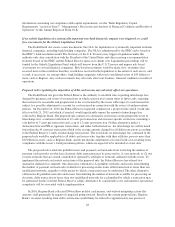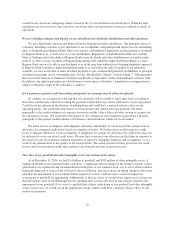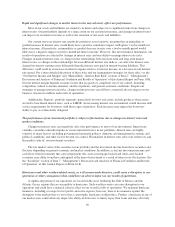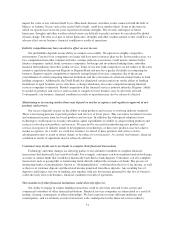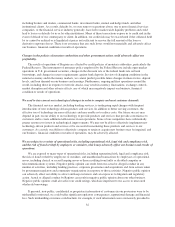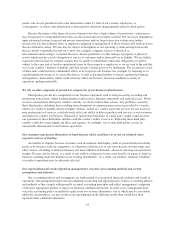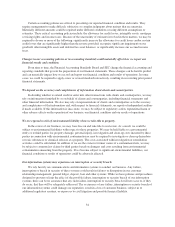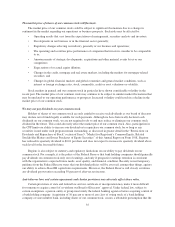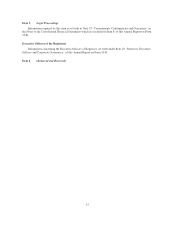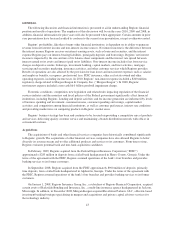Regions Bank 2010 Annual Report Download - page 47
Download and view the complete annual report
Please find page 47 of the 2010 Regions Bank annual report below. You can navigate through the pages in the report by either clicking on the pages listed below, or by using the keyword search tool below to find specific information within the annual report.parties who are not permitted to have the information, either by fault of our systems, employees, or
counterparties, or where such information is intercepted or otherwise inappropriately taken by third parties.
Because the nature of the financial services business involves a high volume of transactions, certain errors
may be repeated or compounded before they are discovered and successfully rectified. Our necessary dependence
upon automated systems to record and process transactions and our large transaction volume may further
increase the risk that technical flaws or employee tampering or manipulation of those systems will result in losses
that are difficult to detect. We also may be subject to disruptions of our operating systems arising from events
that are wholly or partially beyond our control (for example, computer viruses or electrical or
telecommunications outages, or natural disasters, disease pandemics or other damage to property or physical
assets) which may give rise to disruption of service to customers and to financial loss or liability. We are further
exposed to the risk that our external vendors may be unable to fulfill their contractual obligations (or will be
subject to the same risk of fraud or operational errors by their respective employees as we are) and to the risk that
we (or our vendors’) business continuity and data security systems prove to be inadequate. The occurrence of any
of these risks could result in a diminished ability of us to operate our business (for example, by requiring us to
expend significant resources to correct the defect), as well as potential liability to clients, reputational damage
and regulatory intervention, which could adversely affect our business, financial condition or results of
operations, perhaps materially.
We rely on other companies to provide key components of our business infrastructure.
Third parties provide key components of our business operations such as data processing, recording and
monitoring transactions, online banking interfaces and services, Internet connections and network access. While
we have selected these third party vendors carefully, we do not control their actions. Any problems caused by
these third parties, including those resulting from disruptions in communication services provided by a vendor,
failure of a vendor to handle current or higher volumes, failure of a vendor to provide services for any reason or
poor performance of services, could adversely affect our ability to deliver products and services to our customers
and otherwise conduct our business. Financial or operational difficulties of a third party vendor could also hurt
our operations if those difficulties interfere with the vendor’s ability to serve us. Replacing these third party
vendors could also create significant delay and expense. Accordingly, use of such third parties creates an
unavoidable inherent risk to our business operations.
Our customers may pursue alternatives to bank deposits which could force us to rely on relatively more
expensive sources of funding.
An outflow of deposits because customers seek investments with higher yields or greater financial stability,
prefer to do business with our competitors, or otherwise could force us to rely more heavily on borrowings and
other sources of funding to fund our business and meet withdrawal demands, adversely affecting our net interest
margin. We may also be forced, as a result of any outflow of deposits, to rely more heavily on equity to fund our
business, resulting in greater dilution of our existing shareholders. As a result, our business, financial condition
or results of operations may be adversely affected.
Our reported financial results depend on management’s selection of accounting methods and certain
assumptions and estimates.
Our accounting policies and assumptions are fundamental to our reported financial condition and results of
operations. Our management must exercise judgment in selecting and applying many of these accounting policies
and methods so they comply with generally accepted accounting principles and reflect management’s judgment
of the most appropriate manner to report our financial condition and results. In some cases, management must
select the accounting policy or method to apply from two or more alternatives, any of which may be reasonable
under the circumstances, yet may result in our reporting materially different results than would have been
reported under a different alternative.
33




